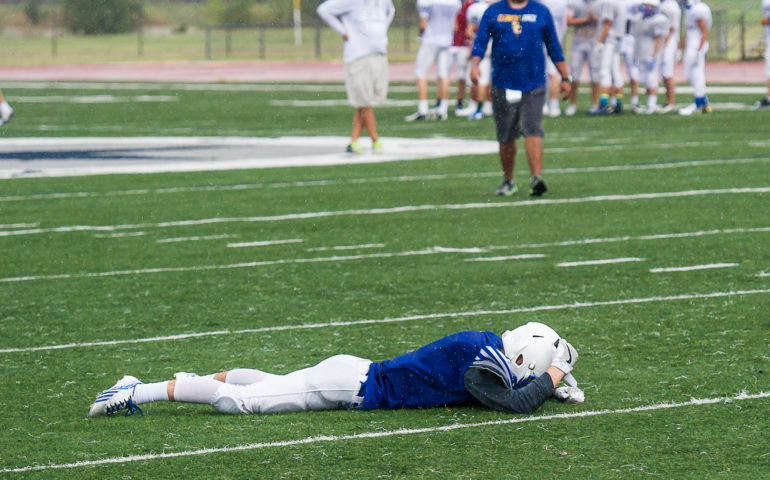Football is one of the most popular sports in the United States, with athletes that range in age from children to adults.
As players rise through the ranks, the demand they put on their bodies from training and competition increases. Weights get heavier, speeds become faster and collisions become stronger. All of these factors play a role in fatigue, both physically and mentally.
This is why a proper recovery routine is just as vital as a strength and conditioning program to keep players performing optimally.
The question some coaches and players have is: What are we recovering from? Whenever the body works at a high intensity, such as during competition, the body succumbs to some amount of fatigue. Fatigue can be either peripheral or central and often a combination of both.
Peripheral fatigue affects muscles, joints, and organs. Central fatigue relates to the brain and the mental effort that is exerted during high-intensity activity.
To recover from peripheral fatigue, the goal is to replenish depleted energy stores. Athletes also want to remove wastes such as lactic acid that build up naturally in muscles.
Finally, there is actual damage to the cells that make up muscles, and athletes need to allow their bodies to heal these cells. There are two ways to go about your recovery, either passively or actively. Passive recovery does not require effort, while active recovery is usually related to low-intensity exercise.
Passive recovery
A passive technique that can help both peripherally and centrally is the use of thermal modalities or anything where you apply heat or cold to the body.
Common heating techniques include the use of a hot tub, steam room or sauna. Along with increasing blood flow, heat can also have an effect on the nervous system, allowing relaxation to further facilitate recovery.
The most common cold technique is ice water immersion. This helps recovery by slowing down further inflammatory processes.
Another method is a combination of hot and cold called a contrast bath, where athletes alternate between a hot tub and cold tub. This method creates a pumping mechanism within the body’s tissues, thereby assisting the removal of lactic acid. Typically, the temperature should be about 105 degrees for the hot tub and 50 degrees for the cold tub. The ratio for the time between each tub can vary from 3-to-1 to 1-to-1 with the athlete typically finishing in the cold tub.
Various techniques of soft tissue mobilization can be beneficial for whole body recovery. Massage is probably the most well-known form of soft tissue mobilization, and there are many different methods to apply. While each style of massage may be unique, they all assist in recovery similarly, which is to help remove lactic acid.
In addition to massage, there are devices – including hand-held foam rollers – that can produce a comparable result through the use of vibration. Foam rollers can be made from a variety of materials and range in rigidity, so the athlete should use the one that feels most comfortable.
Acupuncture is another recovery technique that can help with relaxation, using thin acupuncture needles to stimulate certain points on the body as well as mobilize fascia.
A final passive recovery method that has become popular is the use of compression. There are various compression garments on the market, which when worn are intended to assist with the flushing of lactic acid away from the extremities. There also are mechanical compression devices that can apply very strong pressure usually from the ends of the extremities towards the body.
Active recovery
Active recovery also can take many forms. The key to active recovery is to do an activity where you do not allow the athlete’s heart rate to go above 60 percent of its maximum while limiting the duration of the exercise to about 30 minutes.
When using active recovery, it is also beneficial to make the activity something that has nothing to do with practice or football, though it can remain competition based. This way it also helps with nervous system recovery while still engaging. Some examples include yoga, walking, swimming, and cycling.
Then there is nutrition. Many nutrients are used up during a bout of intense exercise or competition, and part of recovering is to replenish what was lost.
Rehydrating by drinking plenty of water is key. Likewise, electrolytes, which are lost through sweat and important for muscle function, need to be replaced.
Consuming protein after intense activity helps the body as it works to repair the damage done to muscles. Furthermore, eating foods that have antioxidant and anti-inflammatory properties will give an added boost to your recovery efforts. Examples of these types of foods include turmeric or ginger.
Finally, one part of recovery that is usually overlooked is periodization, an important feature of designing a strength and conditioning program where you can focus on building strength and maintaining what you have built throughout the year. Within that plan should be built-in recovery days so that steady gains can be made without running the risk of plateauing or injury. Keeping this in mind, recovery days from practice should also be scheduled during the season.
As a coach, prioritizing recovery in the schedule will go a long way as far as having your athletes be compliant with a recovery program.
Emilio Rabelo is an assistant athletic trainer and physical therapist for the Oakland Raiders. This is his fifth year working as part of the medical staff for the Raiders. He earned a degree in athletic training from the University of Florida and a doctorate in physical therapy from the University of Miami. He is recognized as a sports certified specialist in physical therapy. Prior to joining the Raiders’ staff, he worked with the Miami Dolphins, Florida International University track and field, University of Miami football, University of Tennessee football and completed a residency in Greenville, S.C.
Original article posted here.

